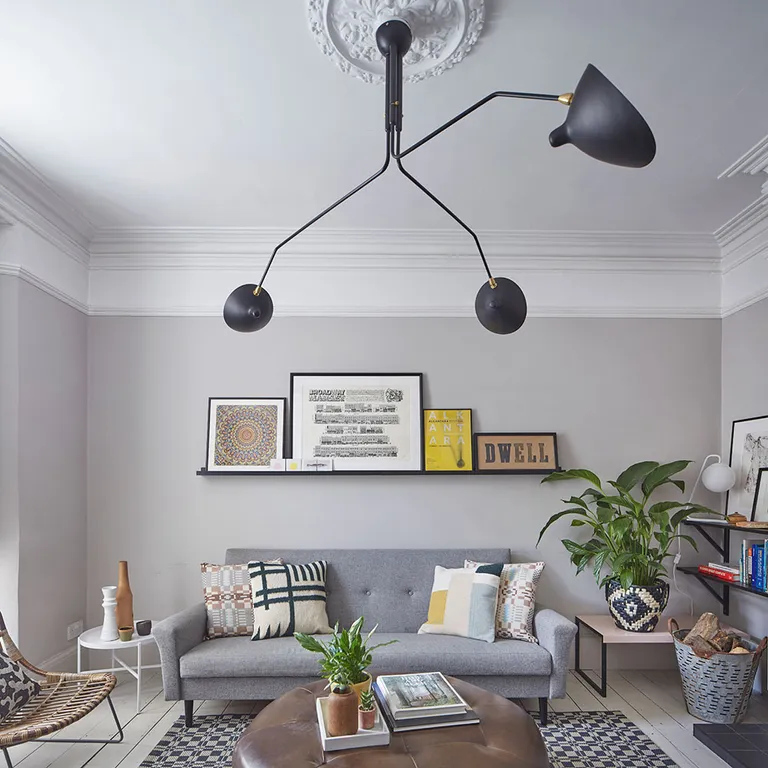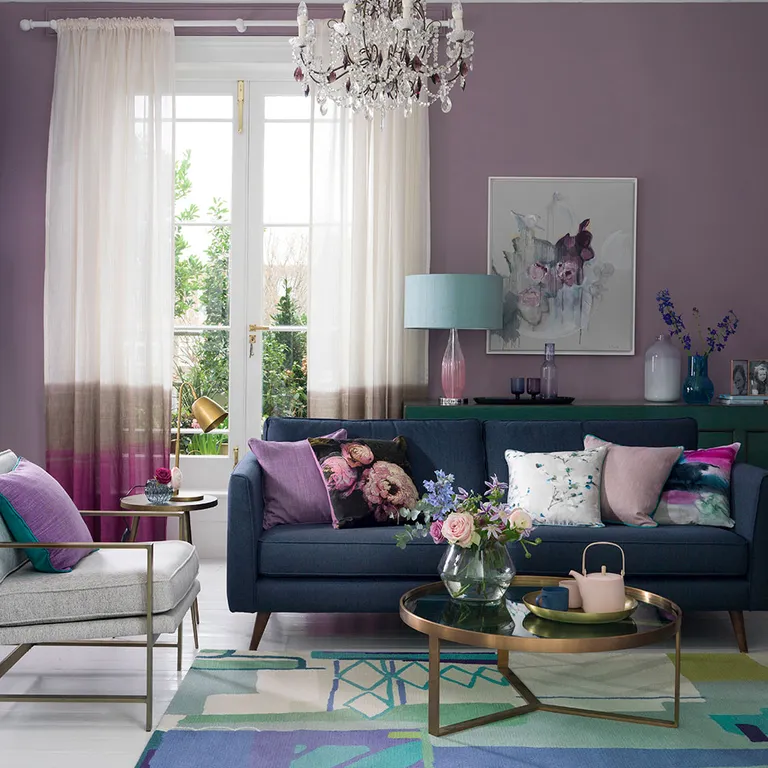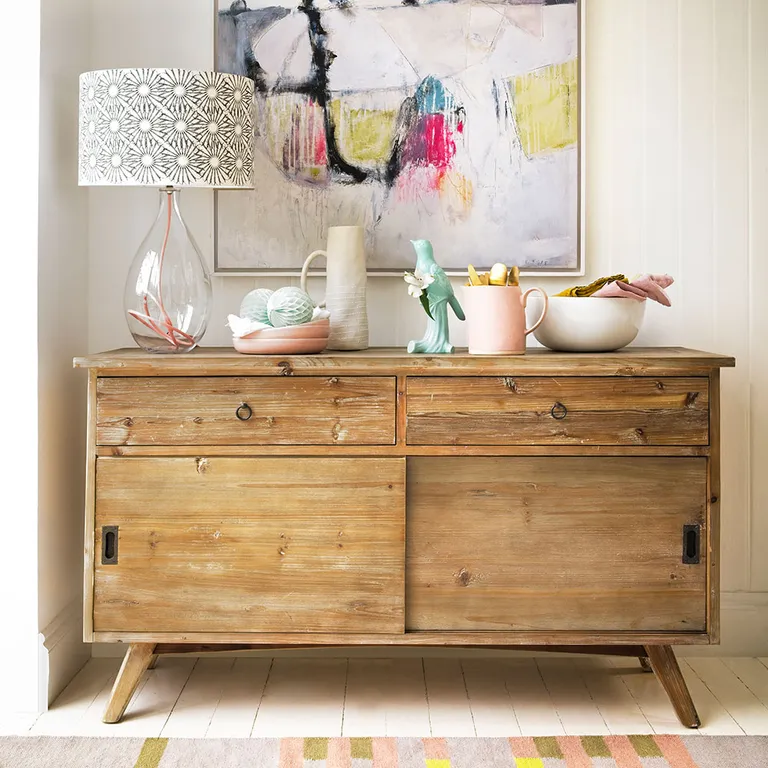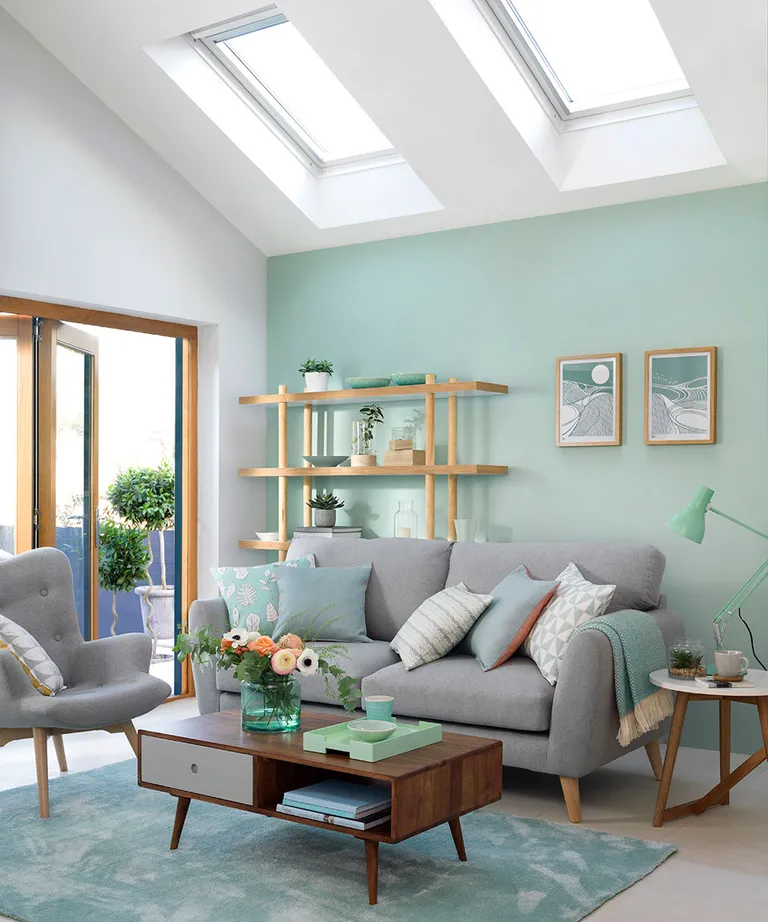Living room lighting ideas – expert tips to improve lighting and create ambience
Good lighting can make or break a scheme, but is often an afterthought. And, with a living area, there’s lots to consider. Finding the right balance of lighting is crucial when it comes to creating the right ambience for living rooms.
From spots to chandeliers, table to floor lamps, getting your living room lighting scheme just right can be complicated. Whether you’re looking to add mood or light up your WFH corner, we asked our favourite lighting experts to shed a little light on the subject.
Living room lighting ideas
Your ambient living room ideas will take the form of a principal light. For good distribution use a pendant, chandelier or spotlights – plus any natural light from windows, doors or skylights. You can then add your task lighting, which is especially useful if you’re also using your living room as a home office, or a place to settle with a good book. Adjustable desk lamps and table lamps both fall into this category.
Aside form the style of lighting you might also want to think about what colour light is best for a living room. Soft or warm white bulbs have a more traditional, cosy feel and are a good way to make a larger room feel relaxed and welcoming. Cool white light, on the other hand, is more energising, and probably better if you have an open-plan space incorporating a kitchen and dining area.
What are the main types of living room lighting?

Image credit: Future PLC
‘There are three distinct types of lighting; task, ambient and accent,’ explains Simon Wallis-Smith, Director and Designer at Fritz Fryer
‘It will help you to choose the correct lighting if you understand the difference between these: task lighting, such as desk lights or spotlights, has a practical purpose; ambient lighting- wall lights, table and floor lamps, and dimmable ceiling lights- creates constant lighting, while accent lighting captures features, creates drama or alters atmosphere’
‘The best schemes include multiple layers of lighting, all doing their bit to create desired levels of illumination and flexibility,’ Simon adds.
How to use living room ceiling lights
1. Pick the perfect pendant

Image credit: Habitat
‘Investing in a feature ceiling light helps to transform your space in two ways: it draws the eye upwards and opens the space up, and tricks the eye into thinking that the space is bigger than it is,’ says Natalie.
‘It’s not always necessary to opt for an overhead light,’ says Jo, ‘but comes down to design preference and how you plan to use the room.’
Simon loves an overhead chandelier: ‘They’re great in a room with high ceilings.’
Buy now: Easton 5 Light Opal Chandelier, £110, Habitat
2. Add on-trend texture with woven pendant shades

Image credit: George Home
‘The right lighting can completely change the look and atmosphere of a room,’ says Simon. Changing a light shade can be transformative to a rooms decor. Not to mention simple and cost effective.
Buy now: Natural Corn Husk Pendant Shades, £25 each, George Home
3. Make a statement with a lighting sculpture

Image credit: Future PLC/ David Parmiter
Contemporary lighting can serve as a striking focal point in a living room. If you are blessed with high ceilings, you can really go to town with dramatic and angular fixtures. This owner didn’t let her home’s distinctive Victorian character stop her from indulging in her love of up-to-the-minute design, and picked a modern three-arm take on a chandelier.
She has cleverly chosen fixtures and fittings – such as the picture ledge side table and shelves – with strong black lines to bring cohesion to the look.
4. Go glam with a glass droplet chandelier

Image credit: Future PLC
Chandeliers might not be as popular as they were ten years ago, when shabby chic fixtures were all the rage. But they can still be a classy and contemporary lighting option. To bring them up to date, pair them with a scheme that’s rich in deep jewel colours such as amethyst purple, sapphire blue and emerald green, and brass and bronze-finished furniture and accessories.
When used as a central lighting choice, it may be that you hardly use this as your lighting option – it can be there to provide more of a decorative purpose. A top tip when choosing chandelier is to opt for a dimmer switch, to allow you to control how bright the light is. Use to the nature of having multiple arms, these designs can often be very bright.
5. Match with a coordinated theme

Image credit: Future PLC/ Polly Eltes
The best way to make all your living room lights blend seamlessly, without being too matchy-matchy is by coordinating a theme. The overhead here is a stylist glass take on a traditional Fishermans pendant, and while the task lamp doesn’t ‘match’ its white enamel design has a subtle coastal vibe. Both sit naturally amongst the decor of soft blue hues, with natural linen textures and seaside mementos. When all the lighting elements work together it helps to create a more thoughtful decorating scheme, where the lighting enhances the look – rather than dominates.
How to use living room lamps
6. Create a cosy atmosphere within open-plan layouts

Image credit: Original BTC
‘By creating light and shade areas, you can have cosier spaces within a large area. Mix up the layers of light, highlight architectural features with accent lighting and don’t over-light ares that don’t need illuminating.’ says Simon Wallis-Smith, Director and Designer at Fritz Fryer.
‘Look at your room and decide where function lighting is needed and mood lighting is required’ advises Natalie Mann, New Product Development Co-Ordinator at Iconic Lights. ‘There’ll be some crossover between the two, so dimmer switches will give flexibility to switch between function and mood lighting.’
7. Mismatch lamp shades to make a style statement

Image credit: Pooky
Do all lamp shade sin a room have to match? ‘No,’ says Jo Aynsley, Designer Director at Jeffries Interiors of Edinburgh ‘unless they are a matching pair. For wall lights though, it’s best to match.’
Natalie Mann, New Product Development Co-Ordinator at Iconic Lights, adds, ‘It’s important to work out what kind of light you want. The weight and colour of the shade will impact the amount and tone of light emitted. If you want brightness, consider mesh shades or glass. Or dispense with shades and go for exposed bulbs- Edison-style.’
Buy now: Large Stucco Table Lamp, £120, Pooky
8. Illuminate alcoves and dark corners

Image credit: Future PLC/ Polly Eltes
If you have a dark corner, such as an alcove beside a fireplace a lamp can prove invaluable. This helps to illuminate the space, to make the room feel bigger and add depth. It can also help to make it feel more characterful after dark, as the shadows play with the space to create interest in contrast to the light bouncing directly off a flat wall.
You can chose to direct the light slightly more into the alcove, as opposed to shining it directly outwards – as desired.
9. Shed light on a reading corner with an oversize adjustable lamp

Image credit: Future PLC/ David Giles
For a quiet moment with a book, select an enormous Anglepoise-style lamp with a flexible arm and head to direct the light exactly where you need it. This large-scale design can also create the perfect spotlight for any budding entertainers at family gatherings.
10. Play with scale

Image credit: Future PLC/ Lizzie Orme
‘Think about the size of the room and scale of chosen design’ advises Suzy McMahon, buying director at Sofology. ‘The addition of a large floor lamp can draw the eye, adding personality and making a statement.’
‘However, for smaller rooms, consider floor lamps with slim bases that won’t take up too much space; these also offer a way to light darker corners and hallways without being imposing.’
11. Bring symmetry and order with matching table lamps

Image credit: Future PLC/ Dominic Blackmore
Take a tip from the interior designers and double up for a more professional, put-together look for a living room. Two identical table lamps used either side of the sofa can really anchor a scheme, especially when set on matching tables, with the colour of the lamp bases picked out again in cushions and other details.
12. Add colour and pattern with a mix-and-match lampshade and base

Image credit: Future PLC/ Dominic Blackmore
The right table lamp can brighten up a room even when it’s turned off. The trick here is to mix pattern with block colour and to take two contrasting colours to come up with a combo that really pops. For a more coordinated look, reflect the same colours in combination elsewhere – here, you’ll see them echoed in the sofa and cushions.
13. Welcome fashionable flex

Image credit: Future PLC/ Dominic Blackmore
The lamp flex – AKA the cable that runs to the plug socket – is having a moment. No longer the poor cousin to a a flashier shade or even bulb, it’s being allowed to make its own style statement with colour and pattern. Here, a blush pink flex stands out against a simple glass base and graphic monochrome shade, and coordinates with carefully chosen ceramics.
14. Match your lighting to the furniture

Image credit: Future PLC/ Simon Whitmore
Despite its importance, lighting can often look like an afterthought. Avoid this (even if it is the case!) by picking lighting in a colour that perfectly matches a key room feature. In this case, it’s a sofa, but it could be your curtains, wallpaper or a rug. Suddenly, your lighting choice looks very deliberate and put together – who would know?
15. Mix materials

Image credit: Sofology
‘Choosing designs with mixed materials such as metal and glass adds texture whilst keeping the look contemporary’ advises Suzy McMahon at Sofology. ‘Although it’s not necessary to match a light’s materials to other pieces in the room, it’s worth opting for styles that complement each other for a cohesive décor scheme.’
‘For example, if your wallpaper features a lot of green, selecting a lampshade in a similar colour will tie the look together.’
Ideas for living room wall lights
16. Keep wall lights simple and sophisticated

Image credit: Fritz Fryer
‘Wall lights are a great addition to a living room,’ says Natalie. ‘They act as a much softer alternative to an overhead light and add visual interest to the walls.’ Keep the design simple and understated for a sophisticated finish.
Simon adds, ‘Wall lights are great for an ambient tone in a room. They create a low level of light and bring out features in a room. It’s all about balancing the layers.’ Jo says wall lights should match, ‘and we prefer downlighters rather than up uplighters.’
Buy now: Ledbury Ribbed Glass Wall Light, £189.25, Fritz Fryer
17. Mimic natural light with wall lights

Image credit: Future PLC/ Lizzie Orme
Placement is an all important factor when it comes to lighting, for any room. With living rooms especially because you are likely to use the room all throughout the day, therefore mimicking the natural light with well-placed lighting options is a favourable idea.
In this bright and airy living room space the wall lights are placed directly above the skylight which floods the room with down light during the day. The wall lights will help to replace/mimic that light once it’s dark outside, giving the room a familiar ambient feel to that of the light during the day.
18. Free up space by thinking vertically

Image credit: Future PLC/ Dominic Blackmore
Who says all lamps having to sit on side tables? Opting for a lamp that can be wall-mounted allows you the freedom to move secondary furniture around more freely, such as side tables. It also means the space isn’t taken up, preventing you using the surface for cups, vases, books etc.
19. Use the walls to allow more focused lighting

Image credit: Nick Smith
Wall lighting provide the perfect way to create a more directional approach with fixed lighting. Choosing wall lights with adjustable rams allows you to concentrate pools of light exactly where you want them to shine, a great characteristic in open-plan living spaces.
As we see in the example above a seating area is well zoned within the open-plan living and dining space. Even when the lights are not in use you immediately know where the point of focus is, thanks to the positioning of the lights poignantly pointed towards a plush, comfy sofa.
Alternative living room light ideas
20. A well placed reading light

Image credit: John Lewis and Partners
As well as being highly practical, an eye-catching floor reading light also adds a contemporary note. Lighting a corner of your living room can give your space a whole new purpose. This type of light delivers a more direct concentrated lighting – perfect for creating a cosy reading corner or a quiet place for crafts.
21. Introduce natural light with skylights

Image credit: Future PLC/ Simon Whitmore
You might think adding roof lights is a huge structural undertaking, but it can be surprisingly easy – especially if you only opt to add one or two. However, the transformation will be instant and dramatic. Velux is a good place to start your research – and if you’d prefer a larger roof lantern, try Apropos.
Natalie adds, ‘Getting the balance right between natural light and fitted lamps can be tricky, so think about what exactly you need.’
22. Make a grown-up display of string lights

Image credit: Future PLC/ Simon Whitmore
Fairy lights don’t have to be exclusive to Christmas trees and kids’ rooms. Pick the right design and they can be used tastefully to light up a dark corner. Cotton ball string lights like these are ideal – provided you stick to tones like white, taupe or soft grey, you’re on to a style winner.
23. Complement lights with lanterns

Image credit: David Brittain
For a relaxed vibe, nothing beats candlelight – and popping said candles inside a lantern will reduce the dangers associated with a naked flame. For total safety, you could even consider using LED candles instead, as once they are inside the lantern, you’ll barely notice a difference.
Rustic washed designs like these work beautifully in a coastal-themed living room – a polished aluminium would work just as well.
The average modern living room will boast at least two different lighting options. From statement ceiling pendants to smart spot lights to provide the main overhead lighting. Accompanied by either floor standing light or side table task lamps to more directional wall lights to create an undertone, proving a more ambient option rather than the main lights.
How do I choose a light for my living room?
Lighting will set the tone of a living room and should never to be underestimated – though sadly, it often is. It might help to think of lighting a room in the same way you’d dress a bed.
With a bed, you start with the basics – a sheet, duvet and pillows, and then add to them with cushions and throws. Similarly, when you’re lighting a room, you start with the primary level of lighting, ambient lighting, and then add in task lighting where you need it.
Jo Aynsley, Designer Director at Jeffries Interiors of Edinburgh says it’s important to recognise how lighting makes us feel: ‘It affects us both physically and psychologically. Good lighting can improve our mood and energy levels. While poor lighting can contribute to depression and affect concentration, sleep, appetite and even our eyesight.’
How do I get mood lighting in my living room?
‘Dimmers can give you good control of light levels in a room,’ says Jo Aynsley.
Natalie Mann, New Product Development Co-Ordinator at Iconic Lights, agrees: ‘Whether they’re wall-mounted dimmable switches or touch lamps with three settings, being able to dim your lights or make them brighter makes for a comprehensive set up.’
It’s about being flexible, explains Simon Wallis-Smith, Director and Designer at Fritz Fryer. ‘Warming up the colour temperature of a light will create depth and a more atmospheric mood. Whereas a cooler light temperature will bring energy levels back up in the room.
‘Successful schemes include lots of layers and the flexibility to individually control each layer, by either dimming or turning on and off.’
The post Living room lighting ideas – expert tips to improve lighting and create ambience appeared first on Ideal Home.




